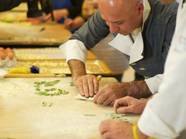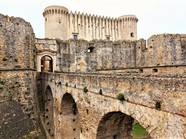An Italian American proposal for the future of Old Lady of Loreto and its statues.
How reading a recent New York Times article may stimulate some creative reflections and maybe a call for talented Italian American artists to save part of our cultural patrimony.
You chose: brooklyn
-
-
On the Eve of the Italian local elections, Letizia Moratti, the Berlusconian mayoral candidate in Milan, slanders his opponent. A few hours later New York City is covered with posters of her face
-
January 20 (6.00 pm). John Turturro is scheduled to meet with Cardinal of Naples Crescenzio Sepe and Antonio Monda at Casa Italiana Zerilli-Marimò. Moderated by Stefano Albertini, they will speak about Naples. Clips from Turturro's latest film, Passione, will be shown
-
How a Roman tradition may be taking over New York. i-Italy walked on the Brooklyn Bridge documenting a new love ritual...
-
The trip of the President of Apulia in the United States. "I was in love with America even when I was radical left"
-
A new book about the New York City waterfront recalls the Italian-American fight against organized crime.
-
Meet KAVES, band leader, tattoo artist, community activist.
-
Art & CultureAnother blog post about a very real event parodying ongoing surreal phenomena.
-
On April 5 2010, a great deal of people rallied to save Our Lady of Loreto Church from destruction. The church is not only a historical symbol for Italian Americans but also offers the possibility of becoming a crucial networking point for a vibrant community.
-
Facts & StoriesOn March 26th, the front page of The New York Times online edition presented the case of the "Our Lady Of Loreto" church in Brooklyn. Residents have long been fighting the decision of the Diocese to demolish this historical monument, built by Italian immigrants in the early 1900s, in order to build in its place low income housing. We had published a story in January 2009, suggesting that the NYT look into it more closely. Our article, written by Joey Skee, reviewed the issue giving plenty of historical and cultural detail; it also hinted that the weakness of the local residents' protest could be explained not only in ethnic-political terms (that is, as a sign of weakness of the Italian American community) but also as the consequence of low rates of church attendance by the local Catholics – the majority of whom now are Latinos, Haitian Americans, and others. Over the years, this led to the site’s increasing disuse, which "transformed it into a dead place, a spent memorial to an Italian-American past." Now that the Italian-American and African-American communities are joining forces in their protest to convert the church into a much needed neighborhood cultural center, we believe that is incumbent on all of us to gather our resources. In so doing, we have decided to re-publish our previous article together with a Facebook message from Senator Diane Savino urging everybody to join the battle.







































